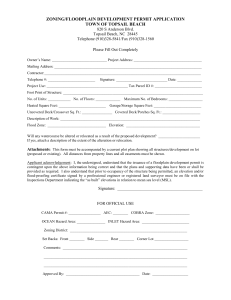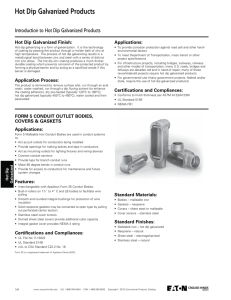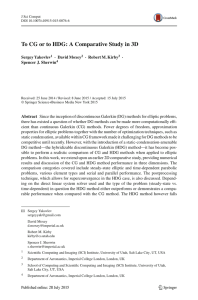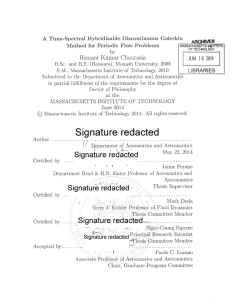CODE CORNER - February 2009
advertisement
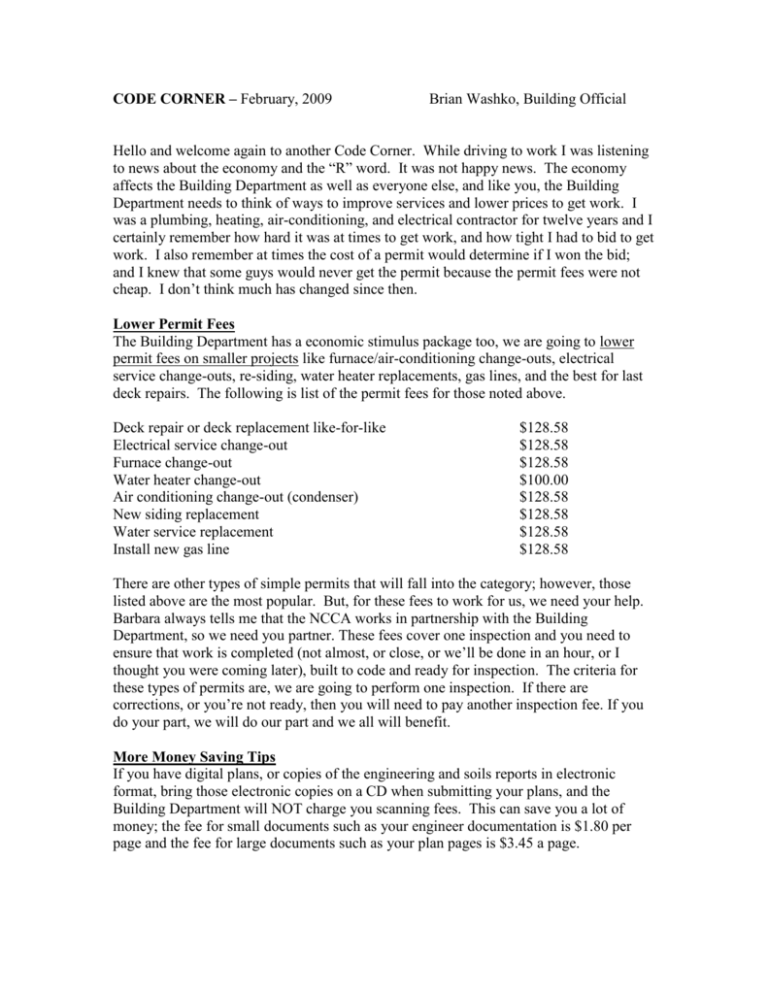
CODE CORNER – February, 2009 Brian Washko, Building Official Hello and welcome again to another Code Corner. While driving to work I was listening to news about the economy and the “R” word. It was not happy news. The economy affects the Building Department as well as everyone else, and like you, the Building Department needs to think of ways to improve services and lower prices to get work. I was a plumbing, heating, air-conditioning, and electrical contractor for twelve years and I certainly remember how hard it was at times to get work, and how tight I had to bid to get work. I also remember at times the cost of a permit would determine if I won the bid; and I knew that some guys would never get the permit because the permit fees were not cheap. I don’t think much has changed since then. Lower Permit Fees The Building Department has a economic stimulus package too, we are going to lower permit fees on smaller projects like furnace/air-conditioning change-outs, electrical service change-outs, re-siding, water heater replacements, gas lines, and the best for last deck repairs. The following is list of the permit fees for those noted above. Deck repair or deck replacement like-for-like Electrical service change-out Furnace change-out Water heater change-out Air conditioning change-out (condenser) New siding replacement Water service replacement Install new gas line $128.58 $128.58 $128.58 $100.00 $128.58 $128.58 $128.58 $128.58 There are other types of simple permits that will fall into the category; however, those listed above are the most popular. But, for these fees to work for us, we need your help. Barbara always tells me that the NCCA works in partnership with the Building Department, so we need you partner. These fees cover one inspection and you need to ensure that work is completed (not almost, or close, or we’ll be done in an hour, or I thought you were coming later), built to code and ready for inspection. The criteria for these types of permits are, we are going to perform one inspection. If there are corrections, or you’re not ready, then you will need to pay another inspection fee. If you do your part, we will do our part and we all will benefit. More Money Saving Tips If you have digital plans, or copies of the engineering and soils reports in electronic format, bring those electronic copies on a CD when submitting your plans, and the Building Department will NOT charge you scanning fees. This can save you a lot of money; the fee for small documents such as your engineer documentation is $1.80 per page and the fee for large documents such as your plan pages is $3.45 a page. Decks – Check This Out One of the big changes in the 2007 California Building Code is Section 1607.7.1.1, which requires handrail assemblies and guards (guardrails) to be able to resist a single concentrated load of 200 pounds applied in any direction at any point along the top, and have attachment devices and supporting structure to transfer the load to appropriate structural elements of the building. To achieve this, a lot of contractors are using Simpson HD2AHDGs. However, they required 3-5/8” diameter HDG machine bolts or threaded rods with nuts and washers. This is labor intensive and not a lot of fun according to the contractors. Simpson has a new product, the DTT2Z that uses one 1- ½” HDG machine bolt or thread rod and use SDS ¼” X 1-1/2” screws instead of the two 5/8” diameter HDG bolts, which should make installation easier. Check out page 165 in the 2009-2010 Simpson Wood Construction Connectors catalog. Please note, I am not endorsing Simpson products or any other products; I am only providing information. Field Issues We have had a few questions and a lot of discussion among staff regarding when a new house or addition is considered weather tight and approved for interior insulation. Obviously, the interior insulation cannot get wet nor be subject to the elements. Some of the questions we recently received are, is Tyvek alone adequate to insulate, or is Tyvek and plywood shear adequate to insulate, or can I just have paper on the roof to insulate? The following is the policy of the Building Department regarding this matter. The interior of a structure cannot be insulated until: The roof covering is completed. Exterior doors and windows are installed Siding is completed, or if a stucco application, lath paper installed. The Building Inspector approves rough frame inspection. The Wonderful City of Grass Valley Many of know that the County of Nevada Building Department is under contract with the City of Grass Valley to provide inspection and plan check services, so it’s only fitting to update you with GV information. In July of 2008, the City of Grass Valley amended Chapter 13.12.050 of the City’s Municipal Code to include a number of provisions for installing backflow (backwater) devices on private sewer lines. The ordinance requires all new buildings to have a backflow prevention device or cleanout placed in the private sewer lateral at or close to the property line, but outside the public right-of-way. This also applies to remodels where plumbing fixtures are added to the property and/or more than twenty-five percent of the structure is being remodeled, or any construction work involving repair or replacement of the sanitary sewer lateral.


